Recently at a guild meeting, a visitor stood up and asked for help getting an antique top quilted. She has been the owner of a family piece – a beautiful Ocean Waves top in blue and white that has been passed down for at least 100 years. It had been sitting in her closet for many years, and she wanted to have it made useable.
 Our guild president told her flatly that it had to be hand quilted. We don’t have any members that hand quilt for clients. The owner was clearly disappointed. She sat back down, and listened to the next part of our presentation.
Our guild president told her flatly that it had to be hand quilted. We don’t have any members that hand quilt for clients. The owner was clearly disappointed. She sat back down, and listened to the next part of our presentation.
At the end, I made a point to go over introduce myself as a machine quilter. I told her I disagreed with the president, and that I could finish her quilt for her. I discussed the popular feeling among some quilters that hand pieced quilts MUST be hand quilted, and that it is only an opinion. I talked about my process, and some steps I could take to preserve the quilt. I encouraged her to look for a hand quilter, and to shop around.
 She called me a few weeks later (hooray!) She wanted her quilt finished and on her guest bed by the time holiday visitors arrived. I had her choose backing fabric she liked from Backside Fabrics. I gave her three choices I liked, but told her it was her quilt and she could pick anything. She chose my favorite one.
She called me a few weeks later (hooray!) She wanted her quilt finished and on her guest bed by the time holiday visitors arrived. I had her choose backing fabric she liked from Backside Fabrics. I gave her three choices I liked, but told her it was her quilt and she could pick anything. She chose my favorite one.
*When clients are non-quilters, or new quilters, it is sometimes easier for them if you limit their choices. Of course they are free to wander around and look at everything, but it can be very overwhelming. Part of my service is to make the whole experience easier.
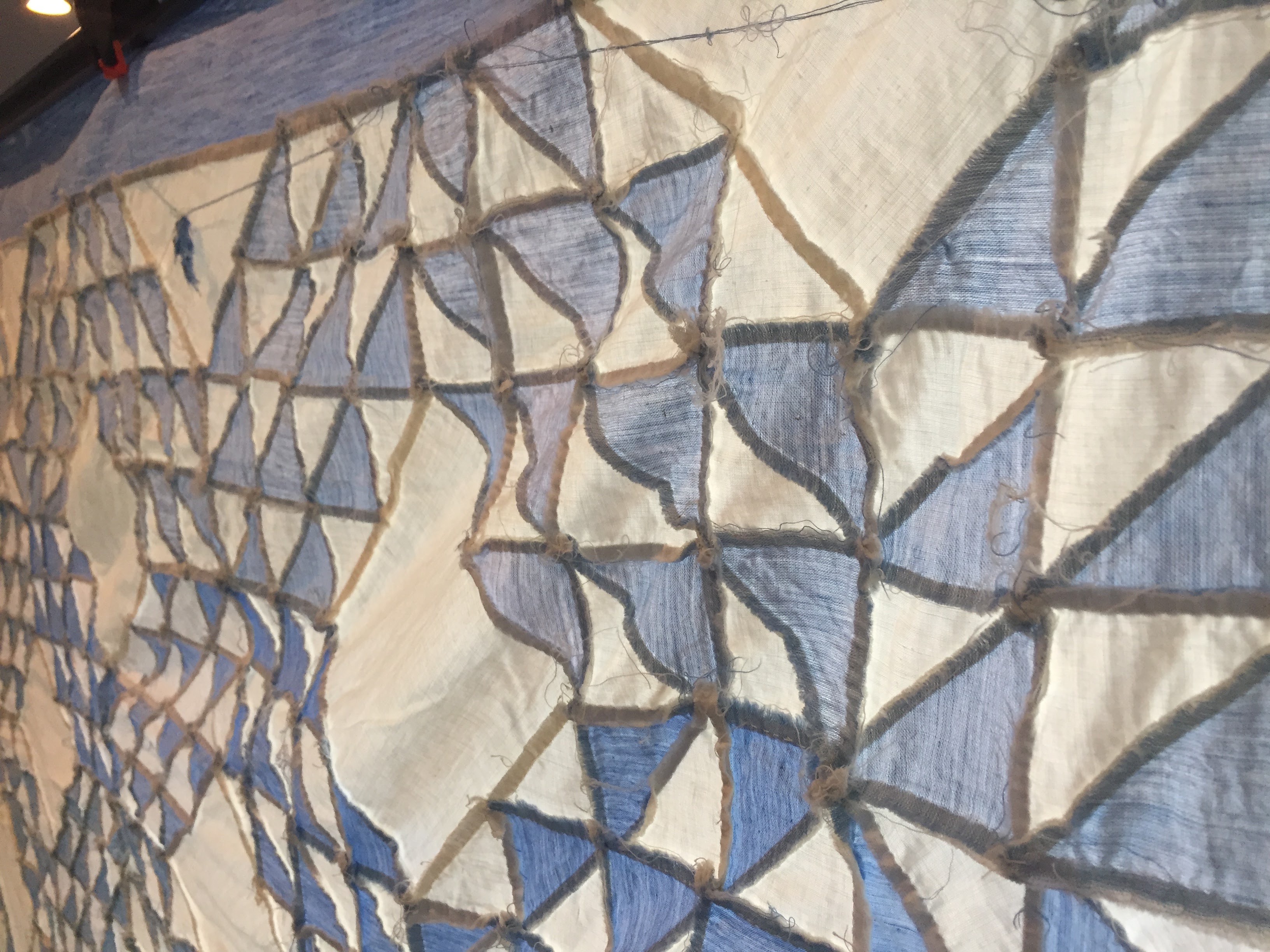 She dropped off the quilt top and backing to me. I finally got my hands on her quilt top. It was big! 88″ x 86″. I was able to see how tightly it was stitched, how wonky it was, and I could tell that at some point in the past it was machine washed and probably dried, too. The back is incredibly frayed, and the loose threads are tangled. I pointed these things out, and explained what I would do to help keep the quilt together. All in all, though, the fabric felt good, not brittle or weak at all.
She dropped off the quilt top and backing to me. I finally got my hands on her quilt top. It was big! 88″ x 86″. I was able to see how tightly it was stitched, how wonky it was, and I could tell that at some point in the past it was machine washed and probably dried, too. The back is incredibly frayed, and the loose threads are tangled. I pointed these things out, and explained what I would do to help keep the quilt together. All in all, though, the fabric felt good, not brittle or weak at all.
My plan was to layer a piece of muslin between the top and the batting. With dense quilting, a loose seam will not result in leaking batting or pieces falling off. Also, if a patch wears out in time, it will be easy enough to appliqué a replacement on top.
I was able to pull out a few different quilts from my collection to show examples of the quilting motif I was thinking of, and also a few different batting options. She preferred the hand of a wool batting, so that is what we went with.
I pre-washed the backing and muslin, to prevent uneven shrinkage in the future. I loaded up the backing as per my usual routine, along with the wool and muslin. I stitched a line of basting across the top with my horizontal channel lock to give myself a line to load the top.
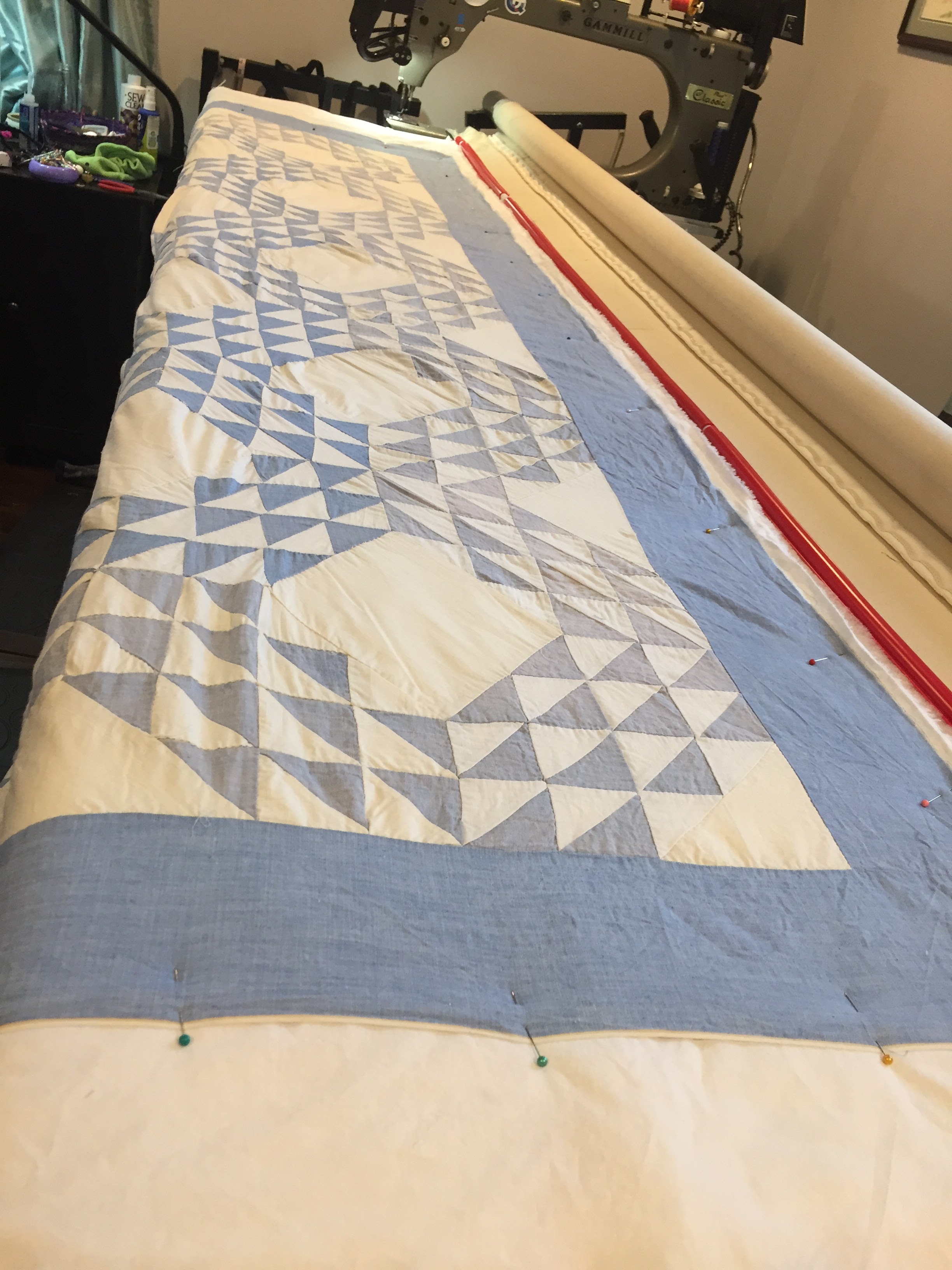 I pressed the top as well as I could, but it felt like an exercise in futility. The more I look at this quilt, the more I can guess why it was never quilted. The original piecer would not have been able to get this piece to lie flat at all. It is all half square triangles, with plenty of inset seams. There is a wide variation in block size. There are plenty of spots where seams were ripped out and re-sewn. There are also spots where pieces are odd shapes.
I pressed the top as well as I could, but it felt like an exercise in futility. The more I look at this quilt, the more I can guess why it was never quilted. The original piecer would not have been able to get this piece to lie flat at all. It is all half square triangles, with plenty of inset seams. There is a wide variation in block size. There are plenty of spots where seams were ripped out and re-sewn. There are also spots where pieces are odd shapes.
I lined up the quilt top with my guide, and basted it down. Usually I baste a whole top, sewing widely spaced lines across it to keep it lined up as I move around the quilt. This time I decided to float it, leaving the un-quilted parts loose. I don’t want to put any extra holes into the top if I can avoid it. The only basting I am doing is along the edge, where it will be covered by binding.
 I stitched along the inside of the border in the ditch to stabilize the center. Then I began doing a continuous curve inside of all of the small triangles. I think this quilting design is also called orange peel and pumpkin seed. It will contain the excess volume, and it will allow me to secure all of pieces. If a seam lets go in time, the patch will still be well secured.
I stitched along the inside of the border in the ditch to stabilize the center. Then I began doing a continuous curve inside of all of the small triangles. I think this quilting design is also called orange peel and pumpkin seed. It will contain the excess volume, and it will allow me to secure all of pieces. If a seam lets go in time, the patch will still be well secured.
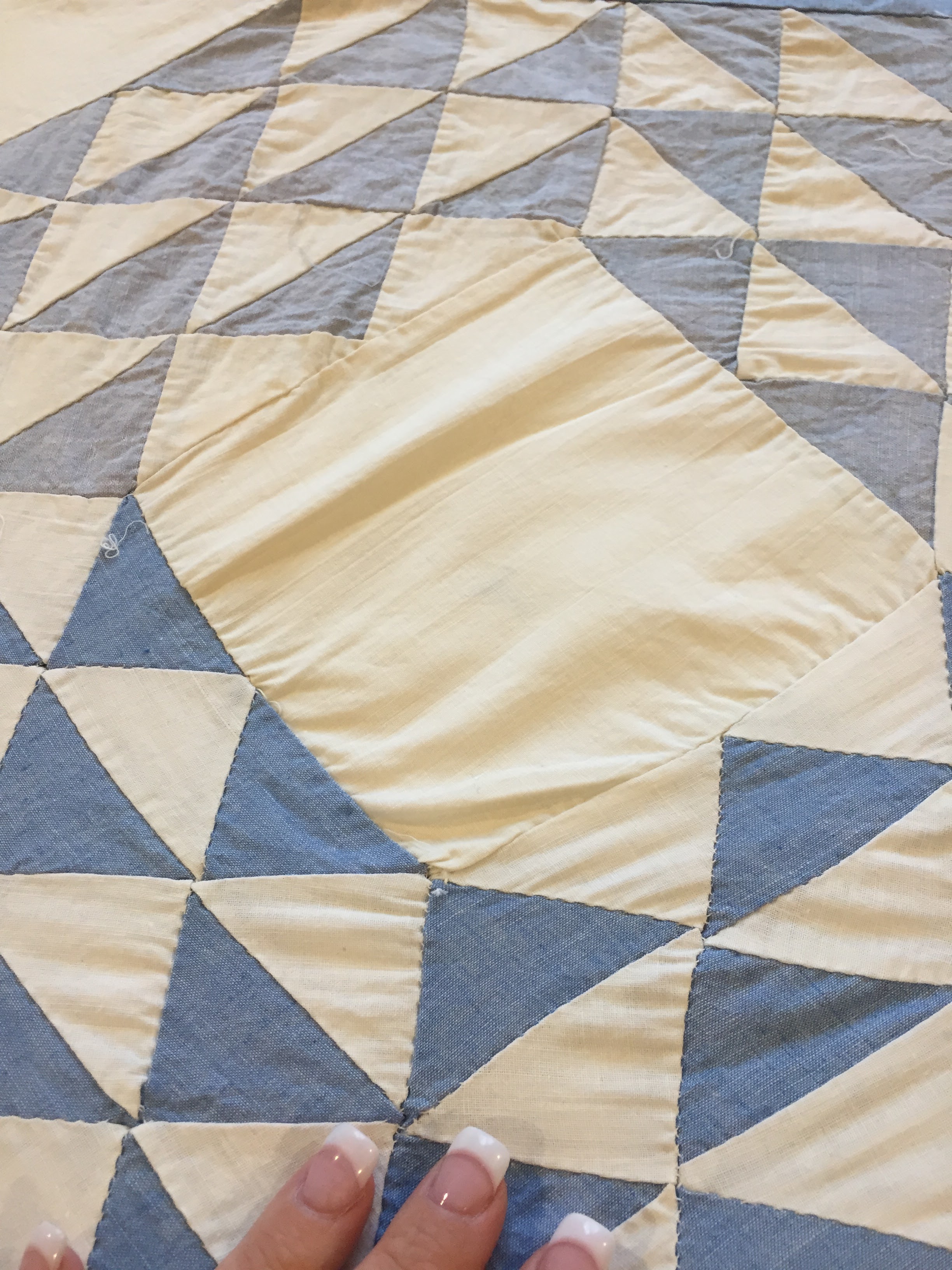 As I advanced the quilt I spent lots of time easing the pieces into square, which created ploofy sections. (This is a technical term.) They then required extra attention. I tugged the pieces where I wanted them, pinned them in place, then sprayed generously with starch. I give it a few minutes, then hit it with steam from my iron. If it isn’t dry, I give it a little more time, then steam it again. It is a slow process, but it makes a big difference. The fabric tightens up, which makes quilting easier.
As I advanced the quilt I spent lots of time easing the pieces into square, which created ploofy sections. (This is a technical term.) They then required extra attention. I tugged the pieces where I wanted them, pinned them in place, then sprayed generously with starch. I give it a few minutes, then hit it with steam from my iron. If it isn’t dry, I give it a little more time, then steam it again. It is a slow process, but it makes a big difference. The fabric tightens up, which makes quilting easier.
I did all of the little triangles first, then went back to the setting squares. I ordered a fancy ruler from Jamie Wallen at Quilter’s Apothecary to help me make feathered wreaths. I start by marking registration lines to center the wreath, along with a little circle at the middle to help guide the feathers. Then I use the ruler to create the circle. Next I stitch the center plumes, then the outer plumes.
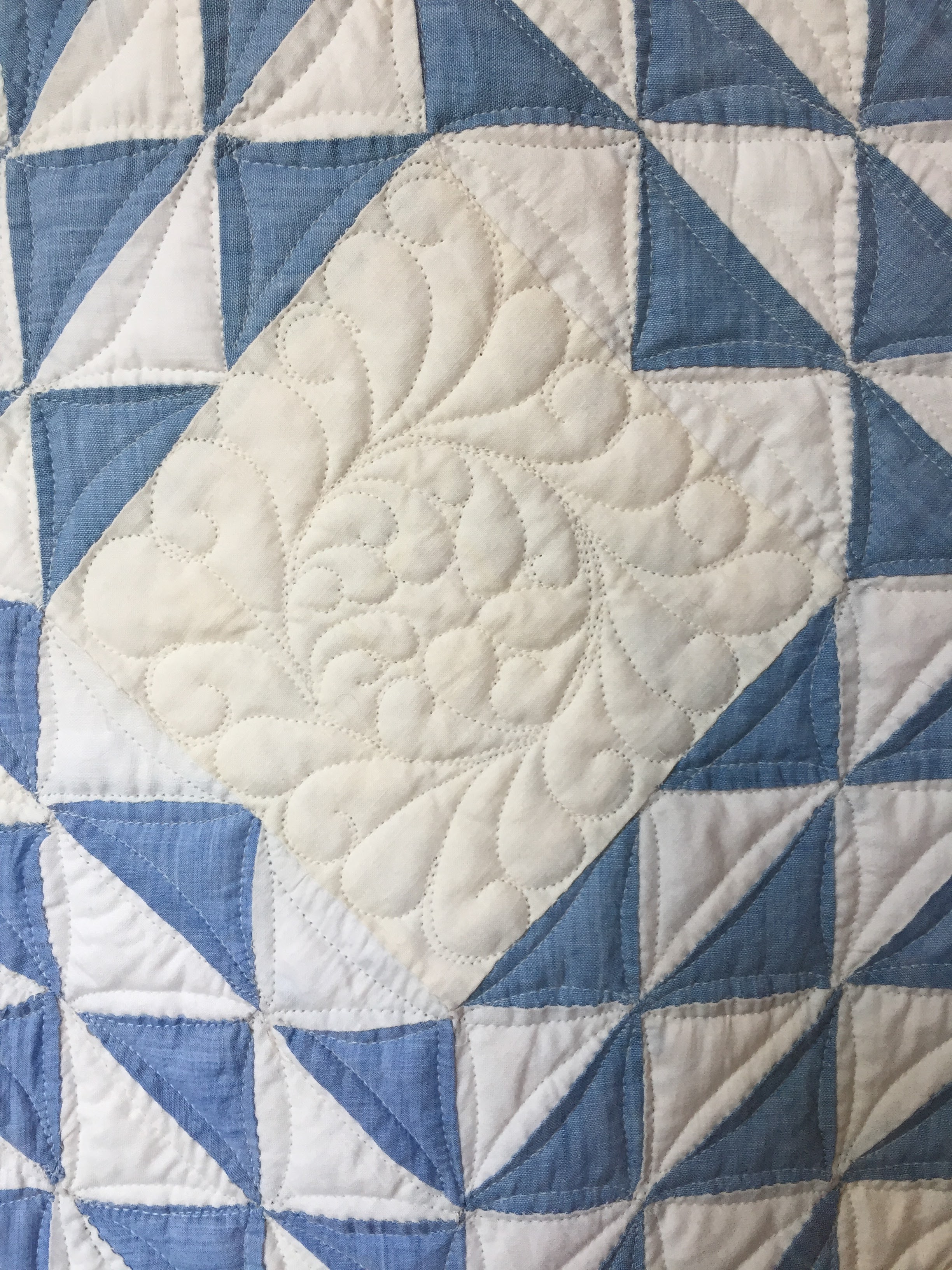 I like to think I’m a modern quilter, but when left to my own devices, it is feathers everywhere.
I like to think I’m a modern quilter, but when left to my own devices, it is feathers everywhere. Finally, I added more feathers in the borders. Why fight it? With a more modern quilt, I would have used piano keys. They are just straight lines, and would help tame the bulk and minimize puckers, but this piece is just too wonderful for such a plain border treatment.
Finally, I added more feathers in the borders. Why fight it? With a more modern quilt, I would have used piano keys. They are just straight lines, and would help tame the bulk and minimize puckers, but this piece is just too wonderful for such a plain border treatment. I used leftover strips from the backing to bind the quilt. My good friend Anne helped me hand bind the quilt during a guild sew-in. (I’ve never sat and worked on a piece at the same time with a friend. I definitely recommend it. Why are there no quilting bees anymore?) Everyone was relieved that I could see the importance of hand binding this one. I complain about hand binding pretty fiercely, but I do know when it is needed.
I used leftover strips from the backing to bind the quilt. My good friend Anne helped me hand bind the quilt during a guild sew-in. (I’ve never sat and worked on a piece at the same time with a friend. I definitely recommend it. Why are there no quilting bees anymore?) Everyone was relieved that I could see the importance of hand binding this one. I complain about hand binding pretty fiercely, but I do know when it is needed.I can’t wait to get this back to the owner and see how much she likes it. She’s a lucky woman – she got a grandson this week, too.
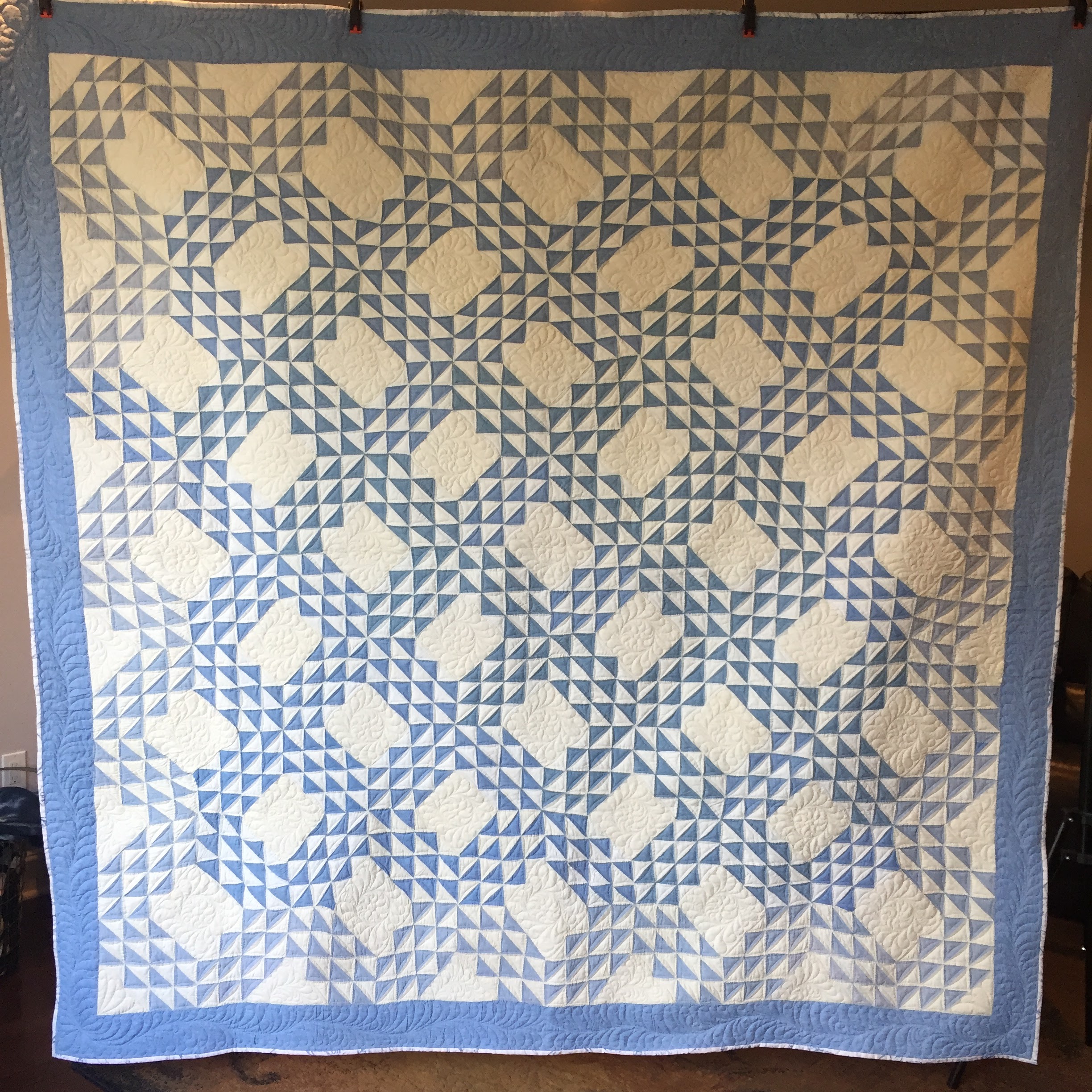 Actually, that is not entirely true. I’d rather keep the quilt, and I’m feeling a little sad that it isn’t mine. On to the next project!
Actually, that is not entirely true. I’d rather keep the quilt, and I’m feeling a little sad that it isn’t mine. On to the next project! And finally, this is a bad little doggie who has been miffed at being kept away from the fancy quilt all week. He was very offended when I did hand work at the dining room table rather than on the sofa, where he could snuggle into it. He used a toy to knock down the photography stand and got onto the quilt. Such defiance.
And finally, this is a bad little doggie who has been miffed at being kept away from the fancy quilt all week. He was very offended when I did hand work at the dining room table rather than on the sofa, where he could snuggle into it. He used a toy to knock down the photography stand and got onto the quilt. Such defiance.Linking up to Main Crush Monday with Beth at Cooking Up Quilts. Check it out and see what other quilters are excited about working on this week.
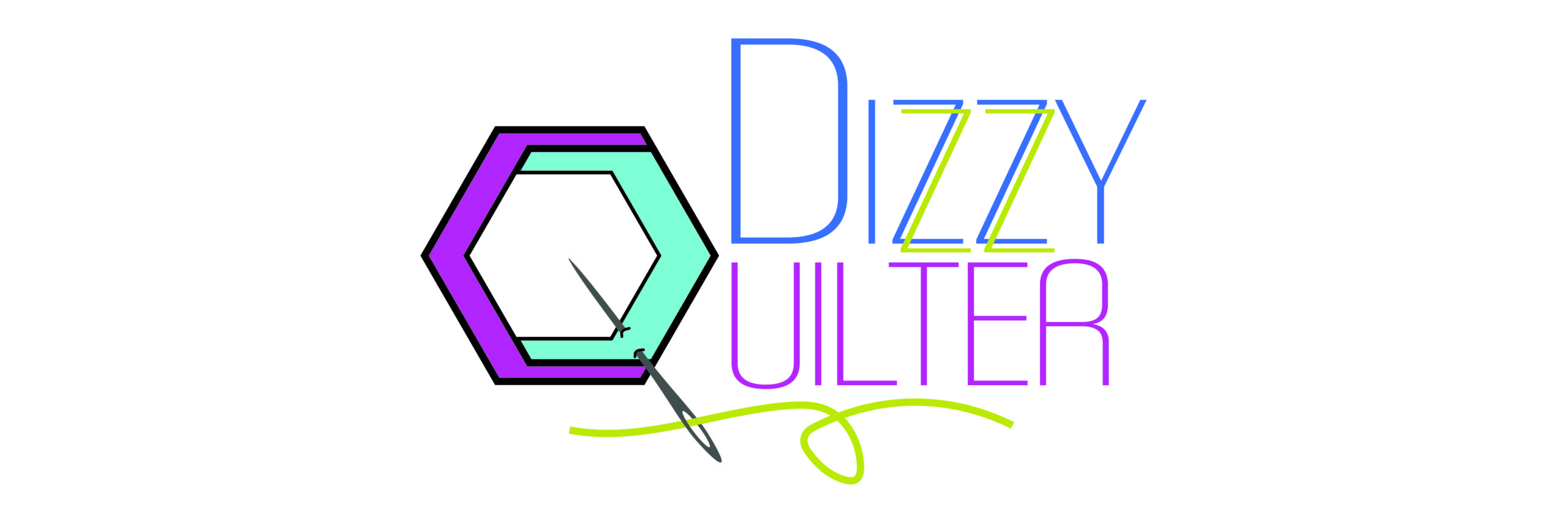
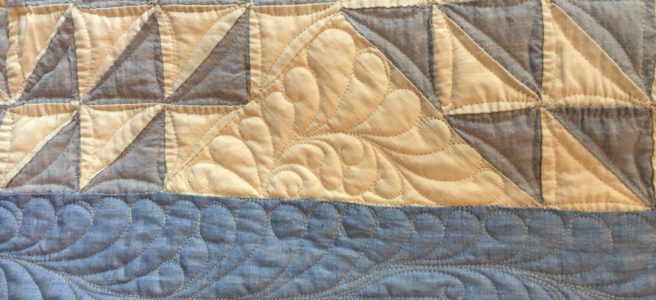
This is absolutely stunning, Jennifer. You did an amazing job and I know your client is going to be thrilled with the result!
Thank you so much!
What a wonderful post with the images and detailing of how you handled the quilt top problems. I too have an old quilt top I’ve mentioned before. Just have to finish the backing and get some $$ together to have it quilted. It is in great shape though – my relative was a professional quilter.
Thanks! That sounds like a fun project.
These posts are from a few years ago so I’m not sure this will reach you. I am quilting a vintage top as well. Did you mention the thread you used? Everyone seems to be using poly spun cone threads on their long arm quilters. What do you recommend for a vintage quilt, quilted on a long arm. Thanks. KC
(chuckling at that bad boy’s “attack” of the stand) WOWOW! This turned out so beautiful. I know how happy she has to be, having quilted an heirloom top for someone last year. It’s really sad that so many quilters refuse to finish a hand-down quilt because it “can only be hand quilted.” I guarantee that if some great-grandchild of mine had a top I’d hand sewn, I’d far rather she had it machine quilted and finished than just let it continue along undone. Your work was perfect for this quilt. Thanks for sharing so much detail of your process.
Thanks so much. I agree – if my treasures tops don’t get finished in my lifetime, I’d rather they be finished and loved than saved for a day that never comes.
Oh my goodness, this was a wonderful post to find! I agree that you don’t have to hand quilt something just because it was hand pieced. I love that you were so careful and meticulous. And the quilt is absolutely beautiful! You saved it from oblivion. Hey – I also learned a lot from your experience. I didn’t know you could put muslin in between the top and the backing to reinforce it that way. And your feathers are awesome – I’ve only been longarm quilting for a year and a half, and feathers still daunt me – but now I’m inspired to give them another go! Thanks so much for the post.
Just FYI; I shared this post with my quilt guild (and my friends) on facebook. It was too good to keep to myself! 🙂
You are so sweet. Thank you.
What an informative, interesting post! I’m so glad you shared it.
Thanks, Regina
WOW! The owner of this quilt is so lucky! You did a fantastic job and I completely understand wanting to keep it for yourself! Thank you for all the tips and advice. I just “repaired” the very first quilt I made, put it in our quilt show, and it’s happily back on our bed!
Thank you!
I’m so glad that you were there that night! I agree with many of the other commenters, I’d much rather have something completed so it can be used and enjoyed than have someone put it off because it had to be done by hand. I appreciate the care you put into this so your client can use this heirloom. Beautiful work!
Thank you!
So beautiful! I know the family must be thrilled to have this heirloom complete!
What is the name of the backing fabric you used on the blue & white vintage quilt?
That is from Tim Holtz, and is called Eclectic Elements Correspondence. It is available from Backside Fabrics. http://www.backsidefabrics.com/108-eclectic-elements-correspondence-sateen-by-tim-holtz-blue/
I love the story of this quilt! I have a passion for vintage quilts and restoring or finishing them. I am so glad you were willing to step forward with your opinion to support machine quilting! And great choices of the quilting…. very nice. Blessings,
Thanks so much!
A stunning quilt, and I really enjoyed reading all about your quilting decisions too!
Thank you, Linda. I’m glad you liked it.
You did beautifull with the quilting! You clearly showed there is beauty in both hand and machine quilting.
Thank you!
I know I’m a little late to this post but just had to say that you did a beautiful job on this and did real justice to the original makers piecing! Did the owner love it? (I know, a silly question, how could she not?!?). And you were right, a vintage top like this CAN be machine quilted very successfully. Since you’ve written this post, there have been many challenges sponsored by designers and longarm companies to have longarm quilters test their mettle at bringing vintage tops to life with machine quilting. Like yours, all the ones I’ve seen to date have been wonderfully finished!
What a beauty! I am going to be quilting a vintage top and I am just wondering about the polyester batting. Do you have any issues with when using an iron?
Hey, Becky – I don’t have a lot of experience with poly batting, and I have never tried to iron it.
I’m so glad I found your post. A friend gave me top found in her grandmother’s house that was quilted by *her* mother (i.e., friends great grandmother). It’s on the frame completely “wonky” and not smooth. I just go out and look at it, sigh, and wander back into the house. You’re given me great ideas to work out. I’m *not* a professional or creative so will go slow. I did stitch cross the top already; I’m trying to figure out how to slip muslin under the top. Such a clever idea.
You showed such kindness and compassion to your client.
Thank you so much. I was looking for a kindred spirit to figure out what to do with a Tree of Life I found in the thrift store. I will definitely use the muslin ‘lining’ to secure the top after I get done resewing the 1/8″ seams. It is beautifully hand pieced and seems to have been washed and dried (a few times). Thank you for taking the time to tell your tale. It has helped a lot.
So beautiful. Thank you sharing your story. I have a few of quilt tops in different stages quality and sizes. I am continuing my search on where to start. Your wonderful post has helped!
I’m so glad it was helpful. Kelly Cline is a great resource when it comes to vintage quilt tops. https://www.kellyclinequilting.com/